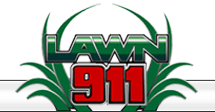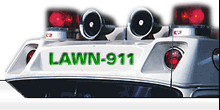
White Grub
The white grub is a C-shaped insect with all 6 of its legs found
directly beneath its head. It has a white body and the head of
the insect is orange. The grub feeds on the roots from May to
September and the damage becomes most evident from June to September,
as there are large brown patches of dead grass. This can be the
most devastating insect, if it is not properly managed.
Bluegrass Billbug
These insects have long snouts, are ¼” long and
are grey or black in colour. The larvae first feed on the grass
stems and then move onto the root system. The insect does the
most damage from July to early August when the temperatures are
high and there is usually drought stress. The injury is visible
in August and can be seen as off-coloured, irregular shaped patches
of turf that turn yellow at first and then brown. The turf can
also be peeled back easily, as the roots have been eaten away.
Chinch Bug
The chinch bug is a tiny red insect at first, but it gets darker
as it matures. It has light coloured forewings, which form a very
noticeable “X” on its back. These insects love to
attack turf when it is weak and that is usually during the summer
in drought-like situations. The damage is noticeable from mid-July
to mid-August and looks like small sunken areas in the lawn that
rapidly turn into large dead areas.
European Cranefly / Leatherjacket
The larvae of this insect is known as the “leatherjacket.”
The leatherjacket stage is when all of the damage occurs, as it
feeds at or below the surface on roots. The damage caused by the
leatherjacket occurs in May. At full size, it turns into a “European
Cranefly” and this resembles a giant mosquito. The European
cranefly is harmless to both humans and the turf.
Sod Webworm
The sod webworm is at its most damaging as a caterpillar or its
larval state. As the spring temperatures rise, it begins to feed
on the turf blades. The adults emerge in May and June and fly
in short zigzag patterns when you walk on the turf. The early
damage looks like scattered brown patches that lead to these areas
turning brown as the feeding intensifies. The injury occurs during
late August and early September.





